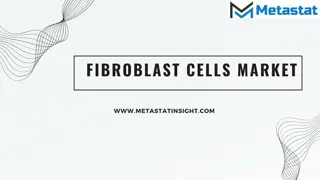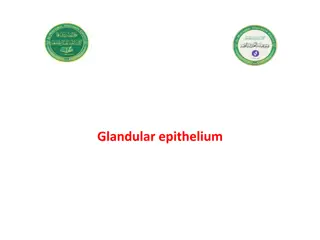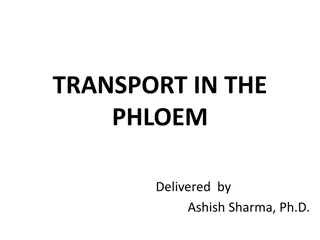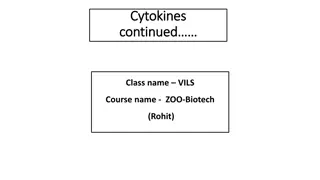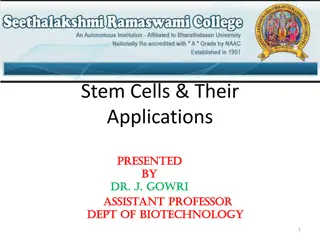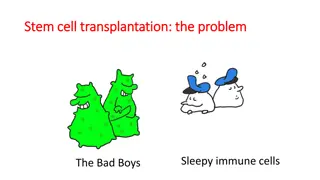CELLS
Discover the incredible world of cells in the human body, each playing a vital role in sustaining life. Explore the diversity of cell types, learn about the history of microscopy, and delve into the Cell Theory. Understand the differences between prokaryotic and eukaryotic cells, essential building blocks of all living organisms.
Uploaded on Apr 06, 2024 | 1 Views
Download Presentation

Please find below an Image/Link to download the presentation.
The content on the website is provided AS IS for your information and personal use only. It may not be sold, licensed, or shared on other websites without obtaining consent from the author. Download presentation by click this link. If you encounter any issues during the download, it is possible that the publisher has removed the file from their server.
E N D
Presentation Transcript
Cells are Basic to Life The human body is composed of trillions of cells. There are about 200 different types of cells. Each cell turns raw materials from food you eat and air you breathe into molecules the body needs. 3
Cell Diversity Cells have many different shapes & functions. Sperm Cells Cheek Cells Nerve Cells Red Blood Cell 4
Microscopes Enable Us to See Cells Microscopes were first developed and used in the 1600 s. Robert Hooke coined the term cell while observing dead cork cells in 1665. 5
Anton van Leeuwenhoek The father of microbiology First to use a microscope to study microorganisms such as bacteria and protozoans A replica of Leeuwenhoek s microscope developed in the 1670 s. 6
The Cell Theory 1.All living things are made of one or more cells. 2.Cells are the basic unit of structure and function in living things. 3.All cells come from pre- existing cells. 7
Two Major Classes of Cells Prokaryotic Cells Eukaryotic Cells Smaller, simpler cells Lack a nucleus and most other organelles Ex. Bacteria & Archaea Have a nucleus surrounded by its own membrane and other membrane-bound organelles. Ex. Protists, Fungi, Plants & Animals 8
Starch Grain 11
Question: Compare and contrast prokaryotic cells and eukaryotic cells. 13
Answer: Both prokaryotic and eukaryotic cells have plasma membranes, ribosomes and genetic material (DNA), but only eukaryotic cells have a nucleus and other membrane-bound organelles. 14
Question: Name two structures found in plant cells that are not found in animal cells. 15
Answer: Any two of the following: Cell wall Chloroplast Large Central Vacuole 16
Membrane Structure & Function
Plasma Membrane The plasma membrane regulates substances moving into and out of a cell. The membrane is composed of phospholipids which have hydrophilic heads & hydrophobic tails. Draw a picture 18
Phospholipid Bilayer The plasma membrane is a phospholipid bilayer; a fluid-like membrane in which the heads face outward and the tails face inward. The tails, tucked inside, act as a selectively permeable membrane. Because the membrane is fluid-like, proteins drift about freely much like icebergs in the ocean. 19
Notice the different types of proteins (blue) embedded in the plasma membrane. Each type has a specific function. 20
Selectively Permeable Membrane The plasma membrane allows some substances to cross more easily than others and blocks the passage of some substances altogether. Three primary ways substances cross the membrane: Passive Transport no energy required Active Transport requires energy Vesicle Transport for large molecules 21
Passive Transport Simple Diffusion Facilitated Diffusion Movement of particles from area of high concentration to area of low concentration Diffusion of particles through a specific membrane protein 22
Diffusion Diffusion occurs because molecules are always in motion. Ex. Dropping food coloring into a glass of water. Eventually, the dye will be evenly distributed. 23
Diffusion and Equilibrium When diffused molecules are equally distributed, and the system is in balance, it has reached equilibrium. Diffusion stops at equilibrium. Molecules are still in motion, but there is no net change in concentration. 24
Facilitated Diffusion The transport protein provides a path for certain molecules to pass through. 25
Osmosis The passive transport of water across a selectively permeable membrane is called osmosis. 26
Osmotic Solutions Hypertonic solution with higher concentration of solute Isotonic solutions with equal concentration of solute Hypotonic solution with lower solute concentration 27
Osmosis & Plant Cells The plant cell wall maintains cell shape. 28
Question: What types of membrane transport are shown in this diagram? 29
Answer: The fat-soluble molecules are crossing the membrane by simple diffusion. The water-soluble molecules are crossing the membrane through a membrane protein, so this is facilitated diffusion. 30
Question: Describe the solutions in this beaker using the terms hypertonic and hypotonic. semipermeable membrane 31
Answer: The solution on the left is hypotonic relative to the solution on the right which is hypertonic. 32
Question: In this solution, only water can cross the membrane. Draw a picture showing how the solutions will change over time. semipermeable membrane 33
Answer: 34
Active Transport Active transport occurs when a cell uses energy to move a molecule across the membrane usually from low concentration to high concentration. 35
Transport of Large Molecules If molecules are too large to cross the membrane, they are packaged in vesicles, which are small sacs that specialize in moving products into, out of, and within a cell. To move products out, the cell uses an active transport process called exocytosis and to take products in, the cell uses endocytosis. 36
Endocytosis 37
Exocytosis 38
Organelles Each mini-organ, or organelle, in the cell has a specific job to do. The various organelles are suspended in a gel-like fluid called cytoplasm. 40
Two Major Compartments Nucleus Surrounded by nuclear membrane Contains DNA Nucleolus (red) makes ribosomes Cytoplasm Contains all other organelles Cytoplasm Nucleus 41
Nucleus This diagram shows the nucleolus and nuclear envelope with pores. The function of the nucleus is to direct the cell s activities. 42
Ribosomes The site of protein synthesis Some are on the surface of rough ER Some are suspended in the cytoplasm 43
Endoplasmic Reticulum The endoplasmic reticulum (ER) is a network of membranes that manufactures & transports cell products. Two types: Rough ER has ribosomes on the surface, makes and transports proteins Smooth ER does not have ribosomes, makes other things like lipids 44
Golgi Apparatus Products from ER travel in vesicles to the Golgi Apparatus Modifies, stores and routes proteins to their destinations 46
Vacuoles Membrane-bound sacs in the cytoplasm that store undigested nutrients Plants have a large central vacuole that stores water Large Central Vacuole 47
Lysosomes Lysosomes are membrane-bound sacs that contain digestive enzymes that can break down molecules. Lysosomes have several functions: 1. Digest nutrients and nourish the cell 2. Destroy harmful bacteria 3. Recycle damaged organelles w/o harming the cell 48
Digestion by Lysosomes When lysosomes digest nutrients, they fuse with a food vacuole Enzymes in the lysosome digest the food particles and nutrients are released for the cell to use enzymes lysosome digestion occurs food vacuole 49
Question: Identify structures 1, 2, 5 & 8. 50





